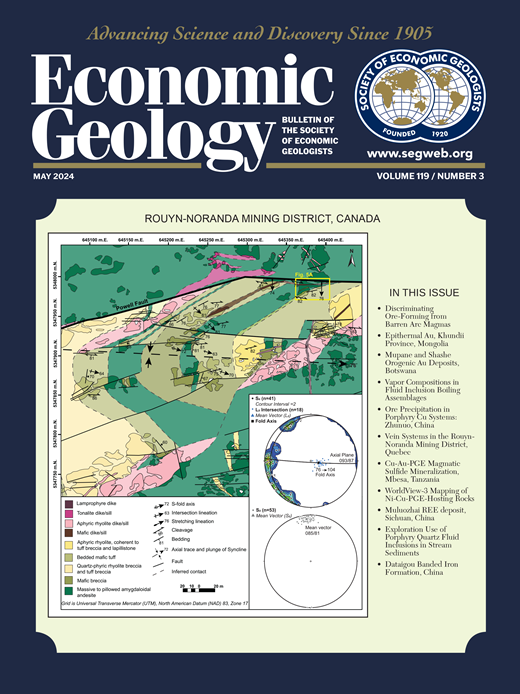THE IMPORTANCE OF GEOLOGY IN ASSESSING BY- AND COPRODUCT METAL SUPPLY POTENTIAL; A CASE STUDY OF ANTIMONY, BISMUTH, SELENIUM, AND TELLURIUM WITHIN THE COPPER PRODUCTION STREAM
IF 5.5
1区 地球科学
Q1 GEOCHEMISTRY & GEOPHYSICS
引用次数: 6
Abstract
The ongoing global transition to low- and zero-CO2 energy generation and transport will require more raw materials and metals than ever produced before in human history to develop the necessary infrastructure for solar and wind power generation, electric power grid distribution, and electric vehicle componentry, including batteries. In addition to numerous critical elements, this transition will also require increased production of a range of other metals. This includes copper, with increased production of this metal providing the minerals industry with enhanced opportunities to secure the additional supply of associated or potential by-product elements. These include tellurium, selenium, bismuth, and antimony (among others), some of which are already predominantly produced as by-products from copper anode slimes. This study examines the geologic origins of over 240 active copper mines and over 200 electrolytic and electrowinning copper refineries worldwide. Although porphyry copper deposits dominate the copper supply trend, significant amounts of copper are supplied from the mining of sediment-hosted, massive sulfide, volcanogenic massive sulfide (VMS), and iron oxide-copper-gold (IOCG) mineral deposits. We integrate sources of copper concentrate with publicly available operational data for 32 copper electrorefineries to evaluate the geologic controls on the by-product supply potential of tellurium, selenium, bismuth, and antimony from copper anode slimes. These data represent some 32% of worldwide copper refineries and indicate that electrolytic refining of copper has the potential to supply ~777 t/yr tellurium, ~4,180 t/yr selenium, ~1,497 t/yr antimony, and 1,632 t/yr bismuth if 100% recovery of the by-product critical element proxies outlined in this study could be achieved. This is compared to current global production of ~490, ~2,900, ~153,000, and ~17,000 t/yr from all sources (rather than just copper by-products), respectively. Our analysis shows that there is no correlation between by-product potential and the amount of refined copper cathode production per year, but instead, the geologic origin of the copper concentrates is the key control on refinery by-product potential. This is exemplified by the fact that copper anode slimes derived from concentrates sourced from magmatic sulfide and VMS orebodies have an order of magnitude higher tellurium concentrations than those derived from porphyry deposits, reflecting the different abundances of tellurium within these mineral systems. These results are not surprising but demonstrate the possibilities for the development of robust proxies for by-product critical element supply potential using downstream data from copper (and potentially other base and precious metal) refineries. Equally significant, this study demonstrates the importance of downstream-up assessments of critical element potential as a complement to the more typical upstream-down deportment analyses undertaken to date. Finally, this type of approach allows the more accurate targeting of key parts of the metal supply chain with the capacity to increase by-product critical element production, rather than diluted or scattered approaches that assume that by-product metals are derived from one or two mineral deposit types (e.g., porphyry systems for the copper sector).地质在评价副产物和副产物金属供应潜力中的重要性铜生产流程中锑、铋、硒和碲的案例研究
正在进行的全球向低二氧化碳和零二氧化碳能源生产和运输的过渡,将需要比人类历史上以往生产的更多的原材料和金属,以发展太阳能和风能发电、电网分配和电动汽车组件(包括电池)所需的基础设施。除了许多关键元素外,这种转变还需要增加一系列其他金属的产量。这包括铜,这种金属产量的增加为矿物工业提供了更多的机会,以确保相关或潜在副产品元素的额外供应。其中包括碲、硒、铋和锑(以及其他),其中一些已经主要作为铜阳极泥的副产品生产。这项研究考察了全球240多个活跃铜矿和200多个电解和电积铜精炼厂的地质起源。虽然斑岩铜矿在铜供应趋势中占主导地位,但大量的铜来自沉积物、块状硫化物、火山块状硫化物(VMS)和氧化铁-铜-金(IOCG)矿床的开采。我们将32家铜电精炼厂的铜精矿来源与公开可用的操作数据进行整合,以评估对铜阳极泥中碲、硒、铋和锑的副产品供应潜力的地质控制。这些数据代表了全球约32%的铜精炼厂,并表明,如果本研究中列出的副产物关键元素替代物能够100%回收,铜的电解精炼有可能提供~777 t/年碲、~ 4180 t/年硒、~ 1497 t/年锑和1632 t/年铋。相比之下,目前全球所有来源(而不仅仅是铜副产品)的年产量分别为490吨、2900吨、153000吨和17000吨。分析表明,副产潜力与年精炼铜阴极产量之间不存在相关性,铜精矿的地质成因是控制副产潜力的关键因素。来自岩浆硫化物和VMS矿体精矿的铜阳极泥的碲浓度比来自斑岩矿床的铜阳极泥的碲浓度高一个数量级,这反映了这些矿物系统中碲的丰度不同。这些结果并不令人惊讶,但表明了利用铜(以及其他潜在的基础和贵金属)精炼厂的下游数据开发副产品关键元素供应潜力的可靠代理的可能性。同样重要的是,本研究证明了对关键元素潜力的上下游评估的重要性,作为迄今为止进行的更典型的上下游部门分析的补充。最后,这种方法可以更准确地定位金属供应链的关键部分,并有能力增加副产品关键元素的生产,而不是假设副产品金属来自一种或两种矿床类型(例如,铜部门的斑岩系统)的稀释或分散方法。
本文章由计算机程序翻译,如有差异,请以英文原文为准。
求助全文
约1分钟内获得全文
求助全文
来源期刊

Economic Geology
地学-地球化学与地球物理
CiteScore
10.00
自引率
6.90%
发文量
120
审稿时长
6 months
期刊介绍:
The journal, now published semi-quarterly, was first published in 1905 by the Economic Geology Publishing Company (PUBCO), a not-for-profit company established for the purpose of publishing a periodical devoted to economic geology. On the founding of SEG in 1920, a cooperative arrangement between PUBCO and SEG made the journal the official organ of the Society, and PUBCO agreed to carry the Society''s name on the front cover under the heading "Bulletin of the Society of Economic Geologists". PUBCO and SEG continued to operate as cooperating but separate entities until 2001, when the Board of Directors of PUBCO and the Council of SEG, by unanimous consent, approved a formal agreement of merger. The former activities of the PUBCO Board of Directors are now carried out by a Publications Board, a new self-governing unit within SEG.
 求助内容:
求助内容: 应助结果提醒方式:
应助结果提醒方式:


